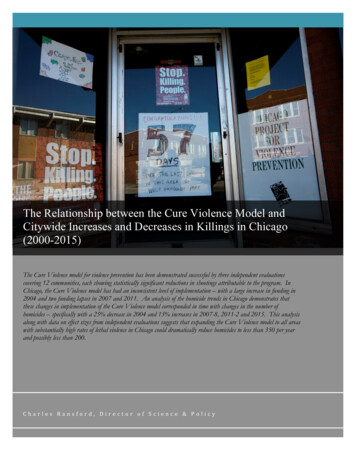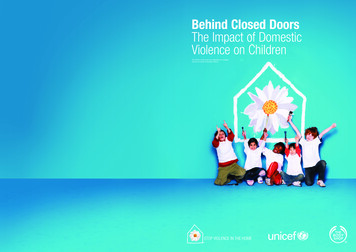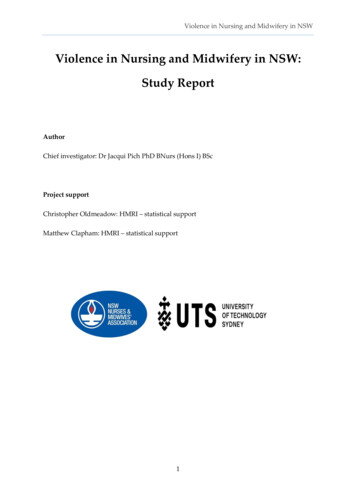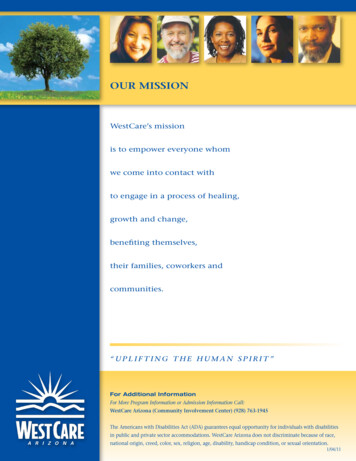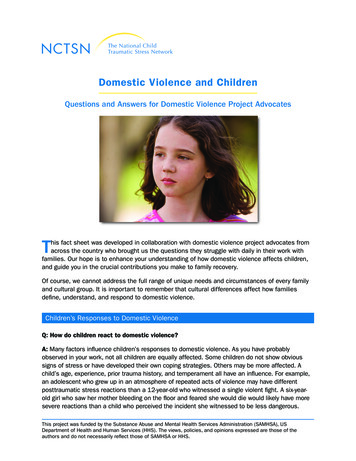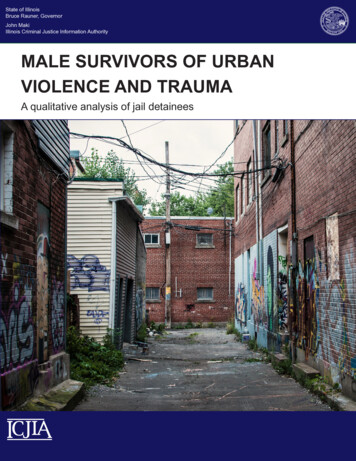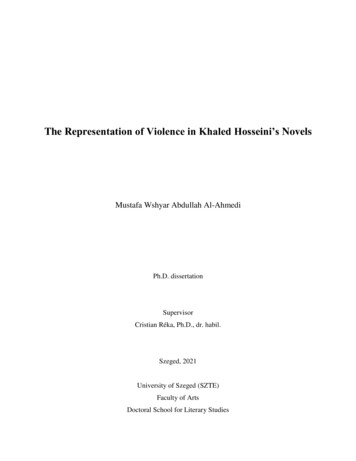
Transcription
The Representation of Violence in Khaled Hosseini’s NovelsMustafa Wshyar Abdullah Al-AhmediPh.D. dissertationSupervisorCristian Réka, Ph.D., dr. habil.Szeged, 2021University of Szeged (SZTE)Faculty of ArtsDoctoral School for Literary Studies
Table of ContentsAcknowledgements1.Khaled Hosseini and His Works . 12.Trauma, Narratology and the Representation of Violence: The Literary Violence Triangle 113.Representing Direct Violence in A Thousand Splendid Suns . 504.Traumatic Experiences and the Narration of Violence in The Kite Runner . 705.Representing Violence and the Role of the Narrator in And the Mountains Echoed . 1006.The Literary Violence Triangle in the Novels of Khaled Hosseini . 129Bibliography . 139
AcknowledgementsFirst of all, I would like to extend my sincere thanks to my supervisor, Dr. Réka Cristian, withoutwhom this work would not have been possible; most of the credit goes to her for her enormoussupport from the first day of my doctoral studies in a foreign country. Her guidance andassistance made me gain courage throughout demanding times. I also owe Dr. György Szönyiand Dr. Attila Kiss for their continual guidance and support in the administration and for givingme feedback for my research progress. I am grateful to Dr. Anna Kerchy and Dr. Ágnes ZsófiaKovács for their fruitful feedback during the courses I had with them; they helped a lot.My family has been the greatest support, they have always been with me during difficult timesand unconditionally supported me. I am genuinely grateful for their presence in my life.My wife, Skala, has truly enlightened my life by providing vital motivation for me to finish mythesis in challenging times. I am indebted to her love and presence that accompanied methroughout my academic journeys and beyond. I will always be grateful to her.
1. Khaled Hosseini and His WorksIn this research, I aim to examine the visible and invisible representation of violence in KhaledHosseini’s three novels, The Kite Runner (2003), A Thousand Splendid Suns (2007), and And theMountains Echoed (2013). Significantly, I will analyze different types of violence in thesenovels through narratological approaches. Also, I will inspect the hidden and untold scenes in thenovels and the role of trauma in violence representation in the narratives. Furthermore, I willdeduce how invisible violence paves the way to a visible one.I am writing on Hosseini’s works as there is no reception on his novels in his country yet in myknowledge and insignificant reception in Anglophone countries. There are newspaper andmagazine reviews, but the critical studies are minimal. Through my researches, no monographappeared on his works; that is why it is essential. It is essential to talk about Hosseini’s works onviolence representation as it is a cultural memory processing that is important for conflictresolution. By reading Hosseini’s novels, I will map the paradigms of violence representationbecause his works employ a multiphase representation of violence. This paradigm willincorporate notions of narratology, trauma theory, and Johan Galtung’s theory to representviolence in Hosseini’s first three published novels.The objective is to analyze the representation of violence through the lens of trauma andnarratological studies. Readers of narratives generally read about what happens in a novel or ashort story. However, these narratives have elements that are barely visible at first sight, hencecategorized as the disnarrated and unnarrated parts of a narrative. What does not happen or is notrepresented in a narrative, generally a hidden or camouflaged representation, is a consequence ofviolent representation. More importantly, mapping the representation of violence on the visibleand invisible levels of the narrative and the connection among the types of violence can help thereaders better understand the representation of violence in literature in a broader perspective.In the first and second chapters, I will survey Khaled Hosseini's life and works; discussbackground concepts related to trauma, conflicts as side facets of violence, and narratology. Iwill identify some key concepts and build the theoretical background to later test to analyze thefollowing chapters' selected novels. Further, the first two chapters will include a summary of1
conflict studies alongside various types of violence, peculiarly the modal of the violence triangledefined by Johan Galtung. At the end of the second chapter, I will also explore the narratologicalmodes of the unnarrated and disnarrated.Following the introduction, I will dedicate three chapters to analyze Hosseini’s novels AThousand Splendid Suns, The Kite Runner, and And the Mountains Echoed. Finally, the lastchapter will conclude my research on the representation of violence in Khaled Hosseini’s threenovels.Violence has consistently been one of the main themes in Khaled Hosseini's writing and otherSouth Asian writers, like Tehmina Durani, Ambalavaner Sivanandan Taslima Nasrin, and manymore. This type of representation is predominantly the result of the geography and history of thearea, which has witnessed conflicts due to ethnicity and religion's heterogeneity. These regionshave also been a central area for the international powers to intervene in exerting their hegemonyand politically influencing regional powers. It is not only armies and superpower countries thatcreate violence; instead, the social, economic, religious, ethnic, and family structures have aidedthe violent developments. As a result, conflict and violence have inspired writers to represent itthrough their fictional works. Durani (1953- ) is a Pakistani writer who wrote extensively onsocial justice, domestic violence, and women's rights. Her first book, written about her life, MyFeudal Lord (1991), was translated into forty languages and received many awards. In her novel,Blasphemy (1998) represents torture and humiliation against Muslim women to the broaderpublic. Sivanandan (1923-2018) was a Sri Lankan novelist and wrote about race and identityissues. The influence of racism on violence creation is the central theme of his novels and othernon-fictional works. Nasrin (1962) is a Bangladeshi-Swedish writer. She is well-known forworks that focus on issues of women and criticism of religion. The theme of struggle is anotherfocus in her novels, and she singularly depicts the case of Hindus trying to survive in the Muslimmajority Bangladesh. The works of these writers, Nasrin as an example, represent the issues oftheir communities. Geographically analyzing, in the past decades, Afghan literature seemed toflourish in trying to represent the Afghan population's condition to the outside world. Novelistslike Mahmud Tarzi, Ahmed Rashid, Asne Seierstad, Atiq Rahimi, Ayesha Jalal, Gayle TzemachLemmon, Hamida Ghafour, and Khaled Hosseini were influenced by the significant political andmilitary outbreaks in the country. Hosseini, moreover, has been influenced by his own past life in2
Afghanistan, America, and the struggle his people witnessed. His novels show the violence andstruggle, just like many other authors in the region.Khaled Hosseini is an Afghan-American novelist. He was born in 1965 in Kabul, Afghanistan,and moved to the USA in 1980. He is the author of The New York Times bestsellers andpublished four bestselling novels until now: The Kite Runner (2003), adapted into a film in 2007,A Thousand Splendid Suns (2007), And the Mountains Echoed (2013), and Sea Prayer (2018). Ichoose only the first three novels as primary texts of this thesis as the fourth book is a graphicnovel, and I do not find it relevant in my dissertation. Hosseini’s works have sold more thanforty million copies in more than seventy countries. Hosseini is also a U.S. Goodwill Envoy tothe United Nations Refugee Agency (UNHCR). In 2007, he established The Khaled HosseiniFoundation, a nonprofit organization assisting the Afghani people; Hosseini states that he hasearned a lot by narrating those people's stories, and it is time to make something in return tothem. Hosseini was raised in Afghanistan and is the eldest of five siblings; his father was a civilservant, and his mother taught Farsi and history in a high school in Afghanistan, where she waslater promoted to the vice-principal rank. He was only eleven years old when his father wastransferred to Paris for a diplomatic mission, and the family moved to France. When communistforces took power due to a military coup in 1978 and then the Soviet invasion, the familyrealized that they could not go back, and the corrupt political situation looked permanent inAfghanistan. They decided to flee to the USA with the help of his father's contacts and seekpolitical asylum there. Hosseini learned English in the USA and was enrolled at IndependenceHigh School in San Jose, California. In 1988, he earned his first bachelor's degree in biology,and following his graduation, he enrolled in a medical school and graduated in 1993, becoming amedical doctor. He served as a practitioner for a year and a half when he published his first novel(Hosseini n.d.; Ghilzai 2016; Famous Authors n.d.; Luebering and Pallardy n.d.).Hosseini pictures a torn and marginalized country that is yet to recover from the years ofinjustice. Many scholars have tried to identify his works as a mere representation of “Muslimother.” The recognition of Muslims in the present has increasingly become constricted, mainlydue to Muslims' political representation post 9/11. Amid the negative portrayal, Muslimsworldwide have suffered from deep contradictions and inconsistencies regarding their vexedidentities. In this context, the Muslim diaspora writers strived to negotiate between their Muslim3
identities and the ethnic and diaspora cultural identities. Hosseini writes about a mix of hisexperiences as an Afghan living in Afghanistan, diaspora, fleeing his home and seeking asylum,and the stories of his people in Afghanistan and other countries as refugees. His traumaticmemories lead him to construct the stories in novels depicting violence (Netto 2009, 55). Thereare many factors responsible for the present plight of the country. Afghanistan had been a merevictim of its history and geography. Over the last three decades, imperialist intervention inAfghanistan has been aimed to free the country from poverty, patriarchy, and feudalism, whichwere regarded as the sign of backwardness by the western population. Before the communistcoup of 1978 and the Soviet invasion of 1979, Afghanistan was considered the most peacefulcountry in the Asian continent. Considering the geographical positioning in Central Asia, in the19th century, the country fell prey to the rivalry between the British and Russian empires.Russian invasion into Central Asia added to India's British rule made Afghanistan a potential baitfor both.Its conflicting geopolitical environment has constituted Afghanistan. It also became the groundfor conflict between the United States funded Mujahedeen and the Soviet-supported Communistgovernment. Afghanistan has always remained in the grip of conflict and has even been stronglyisolated within the Muslim world. The country's permeable geographic boundaries made it easyat stake in the hands of the potential opponents. Iran has made the country a hub of sophisticatednetworks, forming indigenous groups and disciplined forces creating internal pressure. On theother side, Saudi Arabia has a close alliance with the United States and Pakistan to oppose theSoviet occupation in Afghanistan, which Iran considered a significant security threat. Assomeone knowing the novels, life of the novelist, and life in Afghanistan, it is complicated todeny that the novelist is narrating real stories of himself or other Afghanis living there or in thediaspora. The violence reported in real life and nonfiction is the same or at least very similar tothe violence represented in the novels of Hosseini. The novels peculiarly represent the violencein Afghanistan and Afghanis faced and facing rather than showing the issue. Representationupholds authenticity, which is more robust than indicated as the author's fictional texts; it revealsto be more heart touching than treating them as a simple literary work. However, they are stillthe author's imagination products and are dealt with and analyzed as fictional works (PenguinRandom House n.d.). I deal with the novels as fictional narratives and, in my thesis, there is no4
attempt to connect them to the non-fictional context. Hence, I would like to show similarities inthe novels' violence with the existing violence in the non-fictional context, and I mainly use thisapproach in the second and fourth chapters to show a different narrative interpretation style. Thisapproach can introduce a more in-depth analysis of the fictional narratives to explore therepresentation of violence in a literary form.Khaled Hosseini writes his novels after the United States overthrow of the Taliban regime inAfghanistan in 2001, which has been governed poorly. The country's insurgency had drasticallyincreased ever since, with an increasing part of the country in the Taliban's hands. For decades,war-Torn Afghanistan continues to be a hub of growing tension between the United States andother counterparts such as Russia, Pakistan, and Iran. Hosseini started writing his first novel, TheKite Runner, in 2001, but it was only published in 2003, and it is the first Afghan novel writtenin English (Tranter 2013). Reading about the ban of the kite running by the Taliban inAfghanistan inspired Hosseini to write this novel. Following watching the news in 1999 that thegroup bans running kites in the country of which Hosseini says that it was an activity he hadduring his childhood, he writes a short story of twenty-five pages talking about two boys runningkites of which he expanded into a novel later (Brooks 2012). The novel narrates Amir andHassan's story, who are biological brothers from the same father, which is revealed towards theend of the novel. There are many social, cultural, and religious issues covered. Violence is thecentral theme in the novel, similar to Hosseini’s other novels; The Kite Runner represents varioustypes of violence. The text's most dramatic scene is Hassan's rape by another child who is olderthan him. Another intense scene is the stoning of a man and a woman who had sexual affairswithout marrying each other. Thus, Hassan's legal status as an illegitimate child remains thenovel's core issue, although no one knows about this until the narrative ends. After learning thatHassan is his biological brother to search for his nephew, Amir goes back to Afghanistan, as theTaliban have now killed Hassan.One of the issues Hosseini covers in his work is concerns related to ethnicity in Afghanistan.Pashtun is the majority in the country, while there are minorities such as Hazara and Tajik. Herefuses all the talks mentioning that he narrates his life in The Kite Runner as he does not seehimself belonging to only one of those groups “I'm not pure anything There's a Pashtun partof me, a Tajik part of me” (Tranter 2013). The novel is an inclusive text of many ethnic groups5
in Afghanistan, and the author does not favour anyone specifically. He instead tries to build astory dealing with peace and coexistence for everyone in the country and the world. Hosseiniclaims that the novel is not about his life, especially when comparing Amir to the author, but headmits that Baba's characteristics are the same as his father's (Tranter 2013). He also does notdeny that his childhood and his head's voice greatly influence his narratives; he admits that hislife in America has the primary influence on his writings (Mustich 2008). Hosseini is aware thatthere are novels in Afghanistan but written differently from the ones written by Western writersand Afghan writers who have been living in diaspora for a long (Mustich 2008).In Hosseini’s The Kite Runner, violence's representation encourages the reader to relate it to thenon-fictional context when the scenes are compared to Afghanistan and Afghanis' availableknowledge. Thus, The Kite Runner, but all his other novels, have had mixed receptions,especially by Afghani people, as Hosseini's claims exaggerate in many parts. Hence, he neverclaims that he is documenting any reality or nonfiction; he tries to narrate a story in the form of afictional narrative, using his life experiences and identities both as an Afghan and American.There are various types of violence represented in The Kite Runner. There are multiple types ofviolence found, but violence theories can also be implemented and studied through this fictionalwork. That is true that the novel is only narrating imagined stories, but it cannot be denied thatthe story is inspired by real stories as well as the experience of the author. This is a strong pointon which to start building claims and analyze the text using non-literary theories. Those who arenot Afghanis and never lived there can relate the novel to what they hear and see from the news.Many elements make the novel connected to the non-fictional life, such as the ban of the runningkites, stoning adulterous people, and conflict between Hazaras and Pashtuns. Those are thenovel's core issues that the author tries to expand and make them read to get non-Afghanaudiences' attention by referring to things they may have heard of on the news. The authorrepresents its troubled geography and history responsible for the present state, the debilitatedstate, carrying decades of trauma and aims to fictionalize the difficulties of the Afghan people'slife and himself once had similar suffering fleeing the county living in exile under challengingcircumstances. The novel provides hope for the characters in the text and war-torn Afghanistan(CharlieB 2014). Hosseini tries to build hope in the reader's eyes that Afghani people can make ittowards a better life wherever they live despite all the difficulties in Afghanistan. The novel6
reminds the reader how long those people have been living in such difficult circumstances withall the country's existing violence (Hower 2003). The author’s situation shows a collectivetrauma case that he is traumatized like other people in his country. Jeffery Alexander claims thatcollective traumas “have no geographical or cultural limitations” (Alexander 2004, 27).Although Hosseini flees Afghanistan when he is a teenager and spends a more significant part ofhis life in a Western country, there is no escape from cultural trauma.After his first novel's great success, Hosseini started writing the second novel, A ThousandSplendid Suns (2007), as a full-time novelist, quitting his job as a medical doctor. JonathanYardley, a critic in The Washington Post, writes: “in case you're curious, just in case you'rewondering whether in yours truly's judgment it's as good as The Kite Runner, here's the answer:No. It's better” (Yardley 2007). Hosseini shows how life is for women in a society that seeswomen as reproducing tools. Towards the end, the author shows the importance of defeating theTaliban as life starts to return to the country's people (Walter 2007). Like the previous novel,violence is the main issue represented through different incidents. Everything starts with thelegal status of a girl, Maryam, who is born as an illegitimate child. Her mother works as aservant in the house of a wealthy man who already has two wives. When the sexual affair andpregnancy are revealed, he blames her for pushing herself on him.Consequently, the woman is sent to live in a village with her illegitimate daughter. As a result ofno support from anyone when she is a teenager following the suicide of her mother, Maryam isforced to marry a much older man than herself while she is still not in the legal age. Herillegitimate status remains a traumatic event in her life until she is stoned to death as apunishment for murdering her husband. Her illegitimate status leaves her without any familysupport that is significant in a dominant masculine society. The Taliban's political systemfavours masculinity. There is no right and support for the illegitimate children as they are seen as“Haramis,” illegitimate and unwanted children born from a sinful sexual act out of maritalstructures according to the Taliban's beliefs and laws.Violence again is a prominent theme in this novel. The issue is represented, and various aspectsof the issue known mainly in Afghan society are portrayed. However, the represented violence inthe novel does not solely belong to Afghan society. The violence through the novel is an issue in7
many countries and cultures in which human rights are less protected and places that upholdpatriarchy. This novel invites a feminist reading as the issue of equality is the central questionthe author tackles. In the absence of human rights and equality, Maryam and many girls like hersuffer, including another main character, Layla. It is not only women who suffer due to theabsence of those fundamental human rights, but also the male characters; Layla’s lover is anexample.Hosseini clearly says that he wants to discuss politics through his novels (Stuhr 2009, 106). It isnot only the politics, but all the other social issues and violence like in this novel, and he aims tohelp “breathe life, depth, and emotional subtext into the two-dimensional image of the Afghanwoman in a burqa walking down the street” (Mustich 2008). Hosseini is aware that he cannotchange the world in the blink of an eye or a miracle, but issues can be represented in narratives.Fiction becomes a medium for the author to change or at least be the subaltern's voice. This is astatement to build an argument that Hosseini aims to make the reader aware of how people livein some parts of the world and to voice out their suffering: most of the characters in his fictionalworks are Afghanis either living in Afghanistan or people who flee the country to the westerncountries seeking asylum and looking for a safe life. In A Thousand Splendid Suns, the genderviolence against females must have pushed the author to dedicate most of the novel to the issue.Afghanistan is portrayed to the west by the media as the third world with its wars and terrorism,yet Hosseini shows a different Afghanistan whose people have their issues and problems(Kakutani 2007; Kohistani 2005).Hosseini’s third novel is, And the Mountains Echoed (2013). Here the author goes deeper intothe family structure, connecting it to the society, culture, and political system. Family is moreconcentrated on in this novel. It is the story of two siblings, Abdullah and Pari, who are separatedfrom each other since their childhood as Pari is given into adoption to a wealthy family becauseher own family cannot look after her due to poverty. Pari leaves Afghanistan with her adoptivefamily due to the country's security and problems and settles in France, where she becomes asuccessful writer, while Abdullah flees the country to the USA and starts running a restaurantwith his family. They find each other after a long time, but Abdullah is ill and cannot rememberanything about the past. Thus, family ties are a central issue in the novel. Violence is a primaryissue again, as in Hosseini’s previous novels, but different types of violence are represented.8
There is much violence related to the state and other groups, but social/structural and culturalviolence are more evident in this novel, as the core issue which the novel starts with is givingaway a child into adoption due to poverty. Additionally, drawing on “universal signifiers of mythand symbol” states Hosseini's effectiveness as a storyteller (Hore 2013). Hosseini uses fantasy asa myth at the beginning of this novel, which he has not experimented with in his previous novels.According to Helen Brown (Brown 2013), Hosseini listens to his critics, as he was criticized forhis first two novels ending unrealistically. In this novel, he sums up his work more neatly. Thismakes the end of the novel more peaceful, while the ending of the previous ones was moreviolent, especially in A Thousand Splendid Suns, in which the stoning of the main character wasthe final scene.In this novel, Hosseini keeps the family stories central to his narration. Like his previous works,violence is represented, but the representation is different. This time, the novel focuses more onthe structure of relations within the family how the circumstances influence this, as Hosseini saysin a statement: “My new novel is a multi-generational family story as well, this time revolvingaround brothers and sisters, and how they love, wound, betray, honour, and sacrifice for eachother” (Driscoll 2012). The social structure directly influences building the siblings' relationshipas Pari is given into adoption, and she is separated from her brother. The structure of societyviolates the fundamental rights of siblings to grow up together. This is related to the power andeconomic distribution within a society in which some become poor, to the extent that they cannotlook after their children, while others are so rich that they can adopt the children of those whoare less fortunate. The entire social construction builds a cultural trauma that identifies humansuffering (Alexander 2004, 1). And the Mountains Echoed explores the influence of violence ofeconomic inequality on family formation and how the relations formulated in the absence ofjustice and fair opportunities. Although there are many other issues and types of violencecovered, such as invasion, terrorism, and war, the family and the violence committed againstfamily structure remain the novel's central issuesTrauma is a theme we frequently see in this novel; the author attempts to show the effect oftrauma on the people who stay in Afghanistan, those who flee, and those who return to thecountry (Linklater 2013). Indeed, trauma is a language that people use to explain what happensabout themselves and the groups they belong to within society (Alexander 2004, 2). Marcela9
Valdes (Valdes 2013) praises And the Mountains Echoed, saying that it deals with manyemotional aspects such as honesty, loneliness, beauty, and poverty and that it is a novel of “thetransformation of emotions into physical ailments.” The theme of sacrificing as a reason forglobal unfairness and structural violence remains the most touching to the reader. A quote in thenovel clearly explains this situation “A finger had to be cut, to save the hand” (Hosseini 2013,14). Something must always be done unwillingly to let the others or a more prominent partsurvive. Cutting a finger is one of the violent actions that have to be taken to prevent the giant actof violence of losing a hand.Michiko Kakutani (Kakutani 2013) describes this novel as “more fluent and ambitious” than TheKite Runner and “more narratively complex” than A Thousand Splendid Suns. This novel is moreprecise and focused when addressing the issues, while the previous ones addressed gender andwar issues more generally. And the Mountains Echoed considers the smallest parts of acommunity, the individuals forming a family, and their relationships to each other are looked atand looking at the violent factors shaping these relationships. Saying all these, if The KiteRunner was mainly the story of a father with his son, A Thousand Splendid Suns were the storyof a mother and a daughter, then And the Mountains Echoed is the story of two siblings. As aresult, while all the novels are stories of some individuals and are all dealing with particularissues, the last one is more specific when addressing the issues and conveying the detailed scenesusing different narrative techniques.10
2. Trauma, Narratology and the Representation of Violence: The LiteraryViolence TriangleThere is hidden information in fictional texts. Not only what is narrated and shown, but ratherwhat is not shown and represented, should be explored and discussed. Connecting the texts tonon-literary theories helps the reader better understand the approaches and see that literary textsare wide-ranging, covering other fields. Literature is a simplified and fictionalized version of lifethat is complicated and difficult to comprehend.In this thesis, I will look at Khaled Hosseini’s novels to see how violence is represented througha non-literary theory called the violence triangle by Johan Galtung. Galtung is a Norwegianphilosopher who is named mainly by the scholars the father of peace studies. Looking at therepresentation of violence, I use trauma studies and narratology and some other theories,approaches, and models like the theory of mind, significant quest theory, and few others that Iintroduce in later parts of this dissertation. The non-literary sources are not used as a part of thetheoretical background. They are somewhat used to clarify the literary terms and literaryviolence triangle, which is the novelty of this thesis and the supporting purpose of testing literarytheories' process on the selected novels.When there is violence, there is an unhealed or unaddressed trauma. Trauma and violence areconnected because both cause each other in a circular process. It is impossible to determinewhich would come first and which one is the leading cause. In general, when a traumatic eventoccurs, issues that are not dealt with may transfer into violence. Furthermore, there is a hidden orinvisible cause for anything. The invisible and hidden causes are not sufficiently considered, yetno problem can be dealt with unless we go deep to solve the issue fr
A Thousand Splendid Suns (2007), And the Mountains Echoed (2013), and Sea Prayer (2018). I choose only the first three novels as primary texts of this thesis as the fourth book is a graphic novel, and I do not find it relevant in my dissertation. Hosseini’s works have sold more


